Remediation of River Water Contaminated with Whey Using Horizontal Subsurface Flow Constructed Wetlands with Ornamental Plants in a Tropical Environment
Abstract
:1. Introduction
2. Methodology
2.1. Study Area
2.2. HSSFW Design
2.3. Vegetative Development
2.4. Characterization of Wastewater from the River Contaminated with Effluents from the Dairy Industry
2.5. Statistical Analysis
3. Results and Discussion
3.1. Vegetative Development
3.2. Dissolved Oxygen and pH
3.3. Chemical Oxygen Demand (COD)
3.4. Total Suspended Solids (TSS)
3.5. Total Nitrogen (TN) Removal
3.6. Ammonium Nitrogen (N-NH4+) Removal
3.7. Total Phosphorus (TP) Removal
4. Conclusions
Author Contributions
Funding
Data Availability Statement
Acknowledgments
Conflicts of Interest
References
- Boguniewicz-Zablocka, J.; Klosok-Bazan, I.; Naddeo, V. Water quality and resource management in the dairy industry. Environ. Sci. Pollut. Res. 2019, 26, 1208–1216. [Google Scholar] [CrossRef]
- Shigwan, S.; Nikam, S.; Patil, P.; Ohja, P.; Singh, S. Treatment of Dairy Wastewater Using Constructed Wetland. Int. J. Water Resour. Eng. 2022, 8, 55–66. [Google Scholar]
- Valencia, E.; Ramírez, M.L. La industria de la leche y la contaminación del agua. Elementos 2009, 73, 27–31. [Google Scholar]
- Rocha, J.M.; Guerra, A. On the valorization of lactose and its derivatives from cheese whey as a dairy industry by-product: An overview. Eur. Food Res. Technol. 2020, 246, 2161–2174. [Google Scholar] [CrossRef]
- Sirmacekic, E.; Atilgan, A.; Rolbiecki, R.; Jagosz, B.; Rolbiecki, S.; Gokdogan, O.; Niemiec, M.; Kocięcka, J. Possibilities of Using Whey Wastes in Agriculture: Case of Turkey. Energies 2022, 15, 9636. [Google Scholar] [CrossRef]
- Farizoglu, B.; Uzuner, S. The investigation of dairy industry wastewater treatment in a biological high performance membrane system. Biochem. Eng. J. 2011, 57, 46–54. [Google Scholar] [CrossRef]
- Mesa, O.S.L.; Sureda, N.J.; González, G.E. Formación de docentes en educación ambiental: El caso del programa sobre el buen uso del agua en la microcuenca de naolinco, Veracruz. XI Congr. Nac. De Investig. Educ. 2020, 1–10. Available online: https://www.comie.org.mx/congreso/memoriaelectronica/v11/docs/area_03/1183.pdf (accessed on 22 August 2023).
- Parde, D.; Patwa, A.; Shukla, A.; Vijay, R.; Killedar, D.J.; Kumar, R. A review of constructed wetland on type, treatment and technology of wastewater. Environ. Technol. Innov. 2021, 21, 101261. [Google Scholar] [CrossRef]
- Viveros, J.A.F.; Martínez-Reséndiz, G.; Zurita, F.; Marín-Muñiz, J.L.; Méndez, M.C.L.; Zamora, S.; Herazo, L.C.S. Partially Saturated Vertical Constructed Wetlands and Free-Flow Vertical Constructed Wetlands for Pilot-Scale Municipal/Swine Wastewater Treatment Using Heliconia latispatha. Water 2022, 14, 3860. [Google Scholar] [CrossRef]
- Herazo, L.C.S.; Zurita, F.; Nani, G.; Del Ángel-Coronel, O.A.; Aguilar, F.A.A. Treatment of swine effluent mixed with domestic wastewater and vegetation development in monoculture and polyculture horizontal subsurface flow wetlands. Ecol. Eng. 2021, 173, 106432. [Google Scholar] [CrossRef]
- Saeed, T.; Yadav, A.K.; Miah, J. Landfill leachate and municipal wastewater co-treatment in microbial fuel cell integrated unsaturated and partially saturated tidal flow constructed wetlands. J. Water Process. Eng. 2022, 46, 102633. [Google Scholar] [CrossRef]
- Wdowczyk, A.; Szymańska-Pulikowska, A.; Gałka, B. Removal of selected pollutants from landfill leachate in constructed wetlands with different filling. Bioresour. Technol. 2022, 353, 127136. [Google Scholar] [CrossRef]
- Riggio, V.A.; Ruffino, B.; Campo, G.; Comino, E.; Comoglio, C.; Zanetti, M. Constructed wetlands for the reuse of industrial wastewater: A case-study. J. Clean. Prod. 2018, 171, 723–732. [Google Scholar] [CrossRef]
- Licata, M.; Ruggeri, R.; Iacuzzi, N.; Virga, G.; Farruggia, D.; Rossini, F.; Tuttolomondo, T. Treatment of Combined Dairy and Domestic Wastewater with Constructed Wetland System in Sicily (Italy). Pollutant Removal Efficiency and Effect of Vegetation. Water 2021, 13, 1086. [Google Scholar] [CrossRef]
- Licata, M.; Farruggia, D.; Tuttolomondo, T.; Iacuzzi, N.; Leto, C.; Di Miceli, G. Seasonal response of vegetation on pollutants removal in constructed wetland system treating dairy wastewater. Ecol. Eng. 2022, 182, 106727. [Google Scholar] [CrossRef]
- Sultana, M.-Y.; Akratos, C.S.; Vayenas, D.V.; Pavlou, S. Constructed wetlands in the treatment of agro-industrial wastewater: A review. Chem. Ind. 2015, 69, 127–142. [Google Scholar] [CrossRef]
- Schierano, M.C.; Panigatti, M.C.; Maine, M.A.; Griffa, C.A.; Boglione, R. Horizontal subsurface flow constructed wetland for tertiary treatment of dairy wastewater: Removal efficiencies and plant uptake. J. Environ. Manag. 2020, 272, 111094. [Google Scholar] [CrossRef]
- Sharma, P.K.; Rausa, K.; Rani, A.; Mukherjee, S.; Kumar, M. Biopurification of dairy farm wastewater through hybrid constructed wetland system: Groundwater quality and health implications. Environ. Res. 2021, 200, 111426. [Google Scholar] [CrossRef]
- Pelissari, C.; Sezerino, P.H.; Decezaro, S.T.; Wolff, D.B.; Bento, A.P.; Junior, O.d.C.; Philippi, L.S. Nitrogen transformation in horizontal and vertical flow constructed wetlands applied for dairy cattle wastewater treatment in southern Brazil. Ecol. Eng. 2014, 73, 307–310. [Google Scholar] [CrossRef]
- Vymazal, J. Removal of nutrients in various types of constructed wetlands. Sci. Total Environ. 2007, 380, 48–65. [Google Scholar] [CrossRef]
- Sandoval, L.; Zamora-Castro, S.A.; Vidal-Álvarez, M.; Marín-Muñiz, J.L. Role of Wetland Plants and Use of Ornamental Flowering Plants in Constructed Wetlands for Wastewater Treatment: A Review. Appl. Sci. 2019, 9, 685. [Google Scholar] [CrossRef]
- Nakase, C.; Zurita, F.; Nani, G.; Reyes, G.; Fernández-Lambert, G.; Cabrera-Hernández, A.; Sandoval, L. Nitrogen Removal from Domestic Wastewater and the Development of Tropical Ornamental Plants in Partially Saturated Mesocosm-Scale Constructed Wetlands. Int. J. Environ. Res. Public Health 2019, 16, 4800. [Google Scholar] [CrossRef]
- Khalid, J.M.; Mizanur, R.M.; Moshiur, R.M. Effect of Bulb Cutting and Pot Medium on Propagationof Hippeastrum (Hippeastrum hybridum Hort.). J. Ornam. Plants 2014, 4, 123–132. [Google Scholar]
- Ghosh, D.; Gopal, B. Effect of hydraulic retention time on the treatment of secondary effluent in a subsurface flow constructed wetland. Ecol. Eng. 2010, 36, 1044–1051. [Google Scholar] [CrossRef]
- Akratos, C.; Van Oirschot, D.; Tekerlekopoulou, A.; Vayenas, D.V.; Stefanakis, A.I. Dairy Wastewater Treatment with Constructed Wetlands: Experiences from Belgium, the Netherlands and Greece. In Constructed Wetlands for Industrial Wastewater Treatment; Wiley: Hoboken, NJ, USA, 2018; pp. 175–202. [Google Scholar] [CrossRef]
- Rodriguez, M.O.A.; Honfi, I.A.; Daviña, J. Regeneración de bulbos de Hippeastrum striatum y Habranthus Brachyandrus (Amaryllidaceae) sometidos a corte longitudinal. Boletín Soc. Argent. Botánica 2018, 53, 609–618. [Google Scholar] [CrossRef]
- Fishchuk, O. Comparative flower morphology in Hippeastrum striatum (Lam.) H.E. Moore. (Amaryllidaceae). Ukr. J. Ecol. 2021, 11, 273–278. [Google Scholar]
- Rentería, F.F.G.; García, R.A.A. Determinación de la emisión de sustancias tóxicas gaseosas en el relleno sanitario Curva de Rodas de la ciudad de Medellín. Fac. Ingeniería. Univ. Antioq. 2005, 33, 70–83. [Google Scholar]
- Jerez, E. Revisión bibliográfica El cultivo de las heliconias. Cultiv. Trop. 2007, 28, 29–35. [Google Scholar]
- Landero-Torres, I.; García-Martínez, M.; Galindo-Tovar, M.E.; Leiva-Ovalle, O.R.; Lee-Espinosa, H.E.; Murguía-González, J.; Negrín-Ruiz, J. An Ornamental Heliconias Crop as a Reservoir of the Native Myrmecofauna: A case of Tropical Horticulture in Central Veracruz, Mexico. Southwest. Èntomol. 2014, 39, 135–146. [Google Scholar] [CrossRef]
- Costa, A.S.; Nogueira, L.C.; dos Santos, V.F.; Camara, T.R.; Loges, V.; Willadino, L. Storage of cut Heliconia bihai (L.) cv. Lobster Claw flowers at low temperatures. Rev. Bras. Eng. Agrícola Ambient. 2011, 15, 966–972. [Google Scholar] [CrossRef]
- Maucieri, C.; Salvato, M.; Borin, M. Vegetation contribution on phosphorus removal in constructed wetlands. Ecol. Eng. 2020, 152, 105853. [Google Scholar] [CrossRef]
- Shaukat, S.A.; Shah, S.A.; Ishaq, Y.; Ahmed, M.; Shaukat, S.K.; Shoukat, S.W. Influence of phosphorus fertilization on gladiolus corm and flower production. Sci. J. Agric. 2012, 1, 105–111. [Google Scholar]
- Vymazal, J.; Kröpfelová, L. Is Concentration of Dissolved Oxygen a Good Indicator of Processes in Filtration Beds of Horizontal-Flow Constructed Wetlands? In Wastewater Treatment, Plant Dynamics and Management in Constructed and Natural Wetlands; Springer: Dordrecht, The Netherlands, 2008; pp. 311–317. [Google Scholar] [CrossRef]
- Ding, Y.; Song, X.; Wang, Y.; Yan, D. Effects of dissolved oxygen and influent COD/N ratios on nitrogen removal in horizontal subsurface flow constructed wetland. Ecol. Eng. 2012, 46, 107–111. [Google Scholar] [CrossRef]
- Reeder, B.C. Assessing constructed wetland functional success using diel changes in dissolved oxygen, pH, and temperature in submerged, emergent, and open-water habitats in the Beaver Creek Wetlands Complex, Kentucky (USA). Ecol. Eng. 2011, 37, 1772–1778. [Google Scholar] [CrossRef]
- Yin, X.; Zhang, J.; Hu, Z.; Xie, H.; Guo, W.; Wang, Q.; Ngo, H.H.; Liang, S.; Lu, S.; Wu, W. Effect of photosynthetically elevated pH on performance of surface flow-constructed wetland planted with Phragmites australis. Environ. Sci. Pollut. Res. 2016, 23, 15524–15531. [Google Scholar] [CrossRef]
- Bendicho, C.; Lavilla, I. Sewage. In Reference Module in Chemistry, Molecular Sciences and Chemical Engineering; Elsevier: Amsterdam, The Netherlands, 2017. [Google Scholar] [CrossRef]
- Dhanjai; Sinha, A.; Zhao, H.; Chen, J.; Mugo, S.M. Determination of Chemical Oxygen Demand: An Analytical Approach. In Reference Module in Chemistry, Molecular Sciences and Chemical Engineering; Elsevier: Amsterdam, The Netherlands, 2018. [Google Scholar] [CrossRef]
- Noukeu, N.; Gouado, I.; Priso, R.; Ndongo, D.; Taffouo, V.; Dibong, S.; Ekodeck, G. Characterization of effluent from food processing industries and stillage treatment trial with Eichhornia crassipes (Mart.) and Panicum maximum (Jacq.). Water Resour. Ind. 2016, 16, 1–18. [Google Scholar] [CrossRef]
- Patil, N.S.; Kurhekar, J.V. An investigation of monthly variation of different physicochemical parameters of dairy industry effluent. Sustain. Agric. Food Environ. Res. 2021, 9, 393–407. [Google Scholar] [CrossRef]
- Ahmed, O.M. Point Prevalence Survey for Screening of Carbapeneme Resistant Enterobacteriaceae in ICU Patients using CDC Protocol and Chromogenic Agar. Int. J. Curr. Microbiol. Appl. Sci. 2017, 6, 1884–1893. [Google Scholar] [CrossRef]
- Fernández-Echeverria, E.; Misantla, T.N.d.M.T.d.; Herazo, L.S.; Zurita, F.; Betanzo-Torres, E.; Sandoval-Herazo, M. Development of Heliconia latispatha in constructed wetlands, for the treatment of swine/domestic wastewater in tropical climates, with PET as a substitute for the filter medium. Rev. Mex. Ing. Química 2022, 21, 1–20. [Google Scholar] [CrossRef]
- Queiroz, R.D.C.S.D.; Andrade, R.S.; Dantas, I.R.; Ribeiro, V.D.S.; Neto, L.B.R.; Neto, J.A.D.A. Use of native aquatic macrophytes in the reduction of organic matter from dairy effluents. Int. J. Phytoremediat. 2017, 19, 781–788. [Google Scholar] [CrossRef]
- Méndez-Mendoza, A.S.; Bello-Mendoza, R.; Herrera-López, D.; Mejía-González, G.; Calixto-Romo, A. Performance of constructed wetlands with ornamental plants in the treatment of domestic wastewater under the tropical climate of South Mexico. Water Pract. Technol. 2015, 10, 110–123. [Google Scholar] [CrossRef]
- Decezaro, S.T.; Wolff, D.B.; Araújo, R.K.; Faccenda, H.B.; Perondi, T.; Sezerino, P.H. Vertical flow constructed wetland planted with Heliconia psittacorum used as decentralized post-treatment of anaerobic effluent in Southern Brazil. J. Environ. Sci. Health Part A 2018, 53, 1131–1138. [Google Scholar] [CrossRef] [PubMed]
- Moreira, F.D.; Saraiva, C.B.; Bottrel, S.E.C.; Dias, E.H.O. Feasibility study of constructed wetlands for the treatment of dairy effluents. Rev. AIDIS Ing. Y Cienc. Ambientales. Investig. Desarro. Y Práctica 2021, 14, 176. [Google Scholar] [CrossRef]
- Mohamed, A.; Siggins, A.; Healy, M.; Huallacháin, D.; Fenton, O.; Tuohy, P. A novel hybrid coagulation-constructed wetland system for the treatment of dairy wastewater. Sci. Total Environ. 2022, 847, 157567. [Google Scholar] [CrossRef] [PubMed]
- Saumya, S.; Akansha, S.; Rinaldo, J.; Jayasri, M.; Suthindhiran, K. Construction and evaluation of prototype subsurface flow wetland planted with Heliconia angusta for the treatment of synthetic greywater. J. Clean. Prod. 2015, 91, 235–240. [Google Scholar] [CrossRef]
- A Mohammed, N.; Ismail, Z.Z. Green sustainable technology for biotreatment of actual dairy wastewater in constructed wetland. J. Chem. Technol. Biotechnol. 2020, 96, 1197–1204. [Google Scholar] [CrossRef]
- Rampuria, A.; Gupta, A.B.; Brighu, U. Nitrogen transformation processes and mass balance in deep constructed wetlands treating sewage, exploring the anammox contribution. Bioresour. Technol. 2021, 314, 123737. [Google Scholar] [CrossRef]
- Tanner, C.; Depree, C.; Sukias, J.; Wright-Stow, A.; Burger, D.; Goeller, B. Constructed Wetland Practitioner Guide: Design and Performance Estimates; DairyNZ: Hamilton, New Zealand, 2022. [Google Scholar]
- Alayu, E.; Leta, S. Effectiveness of two-stage horizontal subsurface flow constructed wetland planted with Cyperus alternifolius and Typha latifolia in treating anaerobic reactor brewery effluent at different hydraulic residence times. Environ. Syst. Res. 2020, 9, 25. [Google Scholar] [CrossRef]
- Ramírez, S.; Torrealba, G.; Lameda-Cuicas, E.; Molina-Quintero, L.; Stefanakis, A.I.; Pire-Sierra, M.C. Investigation of pilot-scale constructed wetlands treating simulated pre-treated tannery wastewater under tropical climate. Chemosphere 2019, 234, 496–504. [Google Scholar] [CrossRef]
- Marlena, B.; Yuliasni, R.; Sartamtomo, S. Removal of Ammonia on Catfish Processing Wastewater using Horizontal Sub-Surface Flow Constructed Wetland (HSSFCW). J. Ris. Teknol. Pencegah. Pencemaran Ind. 2018, 9, 15–21. [Google Scholar] [CrossRef]
- Kaushal, M.; Wani, S.P.; Patil, M.D. Harnessing Microbial Potential for Wastewater Treatment in Constructed Wetlands. In Sustainable Green Technologies for Environmental Management; Springer: Singapore, 2019; pp. 271–282. [Google Scholar] [CrossRef]
- Tavares, O.C.H.; Santos, L.A.; de Araújo, O.J.L.; Bucher, C.P.C.; García, A.C.; Arruda, L.N.; de Souza, S.R.; Fernandes, M.S. Humic acid as a biotechnological alternative to increase N-NO3- or N-NH4+ uptake in rice plants. Biocatal. Agric. Biotechnol. 2019, 20, 101226. [Google Scholar] [CrossRef]
- Wu, S.; Zhang, D.; Austin, D.; Dong, R.; Pang, C. Evaluation of a lab-scale tidal flow constructed wetland performance: Oxygen transfer capacity, organic matter and ammonium removal. Ecol. Eng. 2011, 37, 1789–1795. [Google Scholar] [CrossRef]
- Xu, R.; Zhang, Y.; Liu, R.; Cao, Y.; Wang, G.; Ji, L.; Xu, Y. Effects of different substrates on nitrogen and phosphorus removal in horizontal subsurface flow constructed wetlands. Environ. Sci. Pollut. Res. 2019, 26, 16229–16238. [Google Scholar] [CrossRef] [PubMed]
- Mantovi, P.; Piccinini, S.; Marmiroli, M.; Marmiroli, N. Constructed wetlands are suitable to treat wastewater from Italian cheese productions. Water Pract. Technol. 2011, 6, wpt2011045. [Google Scholar] [CrossRef]
- Schierano, M.C.; Panigatti, M.C.; Maine, M.A. Horizontal subsurface flow constructed wetlands for tertiary treatment of dairy wastewater. Int. J. Phytoremediat. 2018, 20, 895–900. [Google Scholar] [CrossRef] [PubMed]
- Yazdani, V.; Golestani, H.A. Advanced treatment of dairy industrial wastewater using vertical flow constructed wetlands. Desalination Water Treat. 2019, 162, 149–155. [Google Scholar] [CrossRef]
- Galve, J.C.A.; Sundo, M.B.; Camus, D.R.D.; De Padua, V.M.N.; Morales, R.D.F. Series Type Vertical Subsurface Flow Constructed Wetlands for Dairy Farm Wastewater Treatment. Civ. Eng. J. 2021, 7, 292–303. [Google Scholar] [CrossRef]
- Minakshi, D.; Sharma, P.K.; Rani, A. Effect of filter media and hydraulic retention time on the performance of vertical constructed wetland system treating dairy farm wastewater. Environ. Eng. Res. 2021, 27, 200436. [Google Scholar] [CrossRef]
- De Oliveira, M.; Atalla, A.A.; Frihling, B.E.F.; Cavalheri, P.S.; Migliolo, L.; Filho, F.J.M. Ibuprofen and caffeine removal in vertical flow and free-floating macrophyte constructed wetlands with Heliconia rostrata and Eichornia crassipes. Chem. Eng. J. 2019, 373, 458–467. [Google Scholar] [CrossRef]
- AL Falahi, O.A.; Abdullah, S.R.S.; Abu Hasan, H.; Othman, A.R.; Ewadh, H.M.; Al-Baldawi, I.A.; Kurniawan, S.B.; Imron, M.F.; Ismail, N. Simultaneous removal of ibuprofen, organic material, and nutrients from domestic wastewater through a pilot-scale vertical sub-surface flow constructed wetland with aeration system. J. Water Process. Eng. 2021, 43, 102214. [Google Scholar] [CrossRef]
- Orduña-Gaytán, F.; Vallejo-Cantú, N.A.; Alvarado-Vallejo, A.; Rosas-Mendoza, E.S.; Sandoval-Herazo, L.C.; Alvarado-Lassman, A. Evaluation of the Removal of Organic Matter and Nutrients in the Co-Treatment of Fruit and Vegetable Waste Using a Bioreactor-Constructed Wetlands System. Processes 2022, 10, 278. [Google Scholar] [CrossRef]
- Pérez-Salazar, R.; Mora-Aparicio, C.; Alfaro-Chinchilla, C.; Sasa-Marín, J.; Scholz, C.; Rodríguez-Corrales, J. Biogardens as constructed wetlands in tropical climate: A case study in the Central Pacific Coast of Costa Rica. Sci. Total Environ. 2019, 658, 1023–1028. [Google Scholar] [CrossRef] [PubMed]
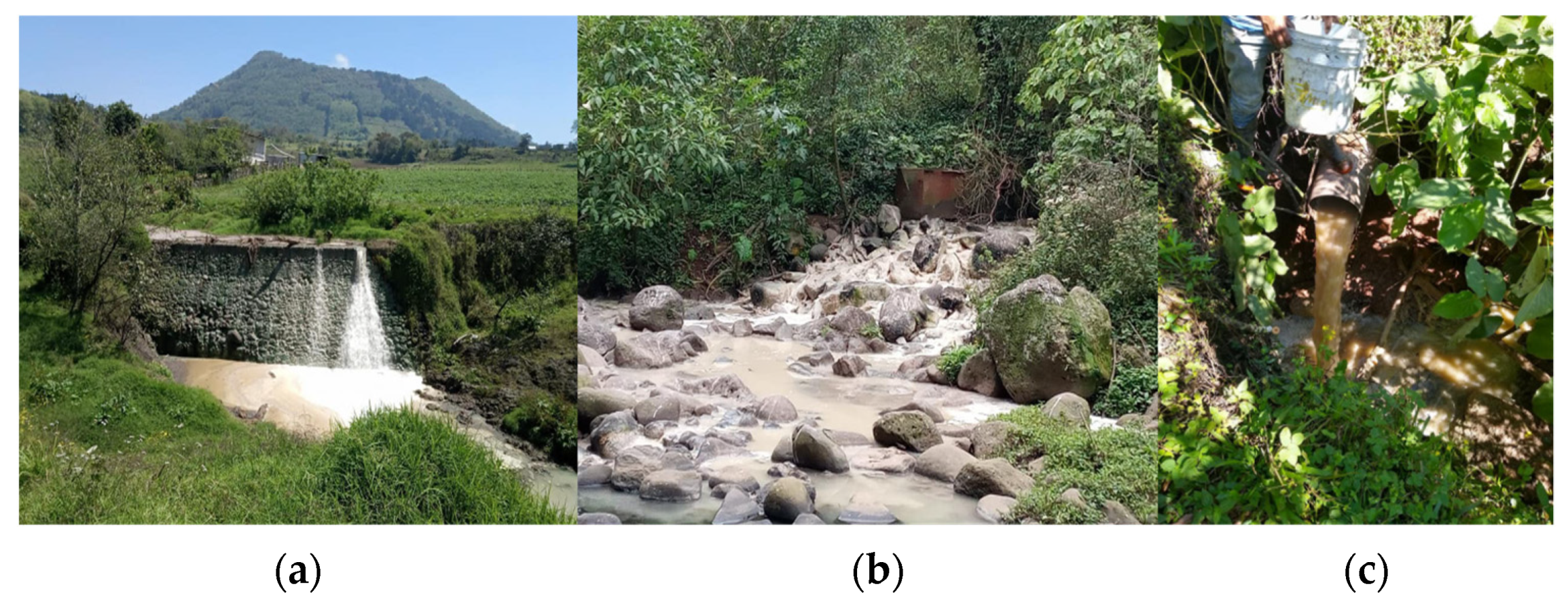
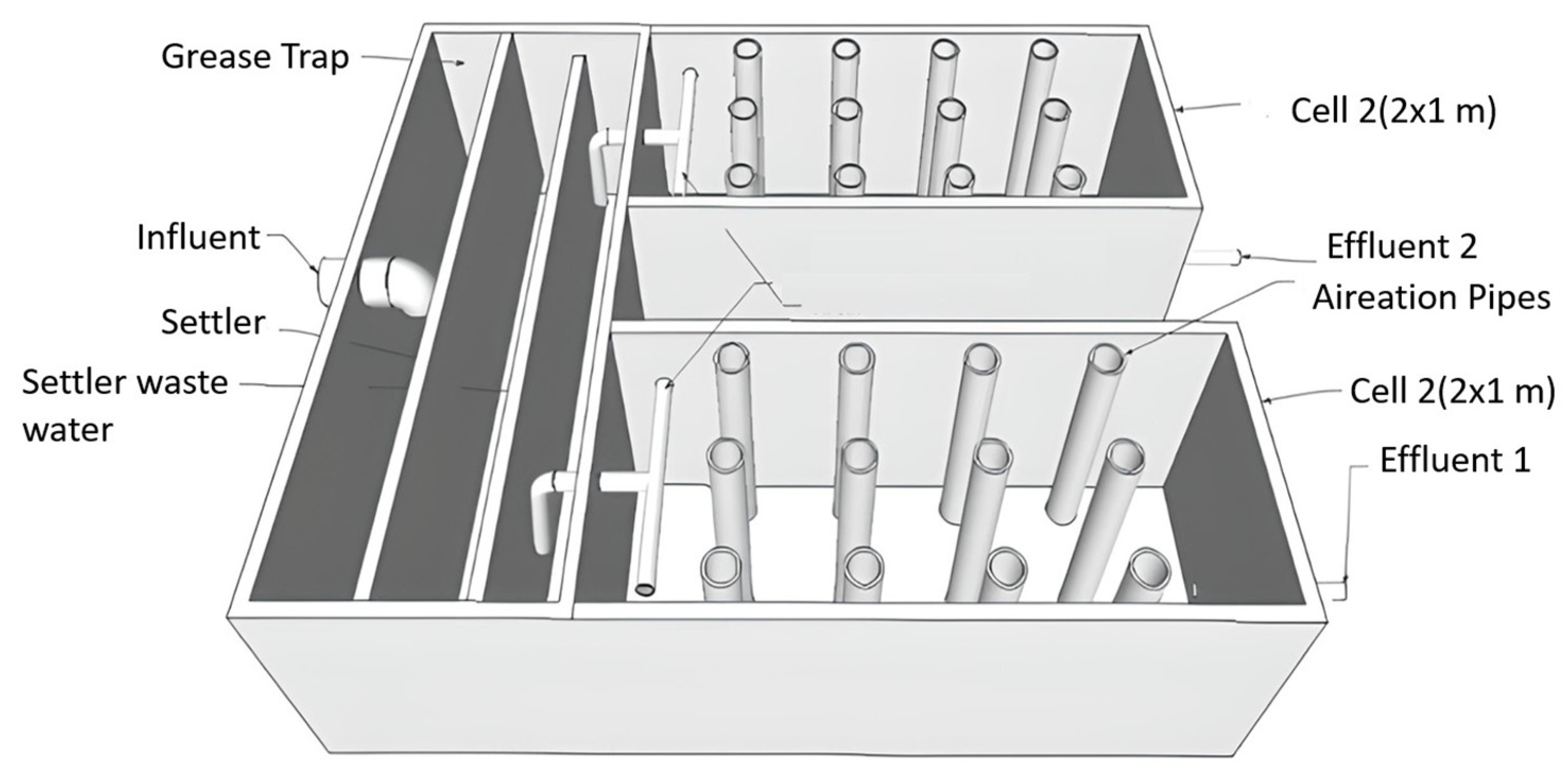
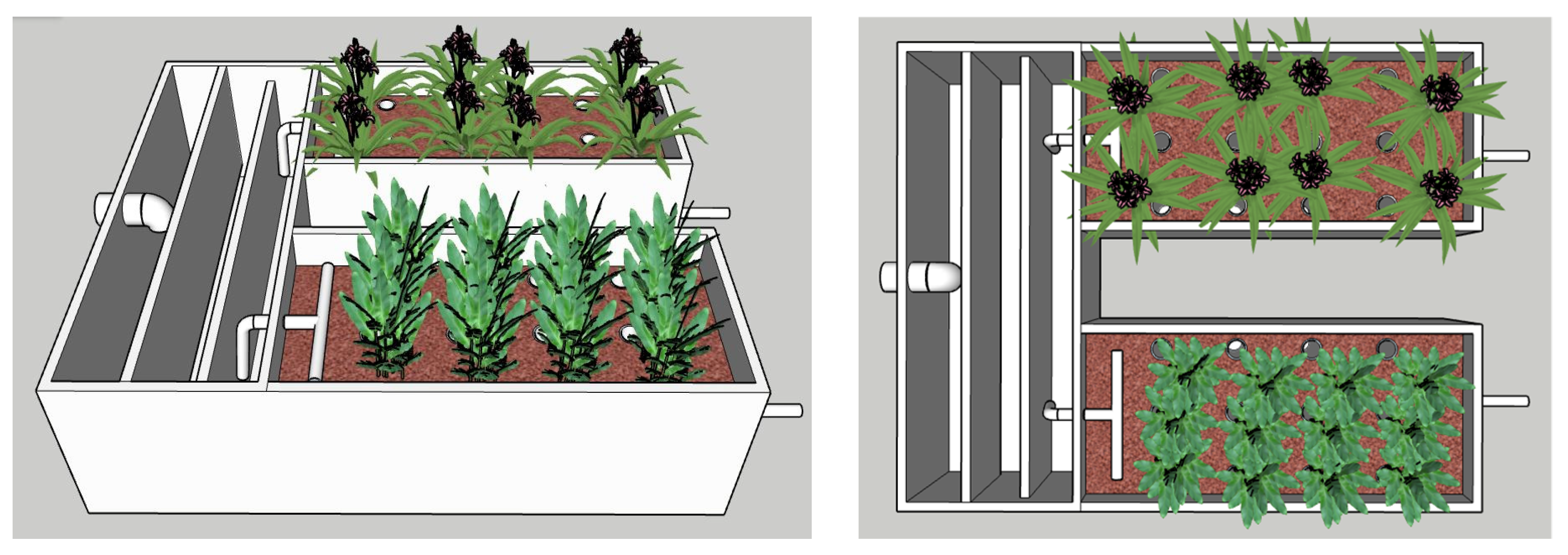

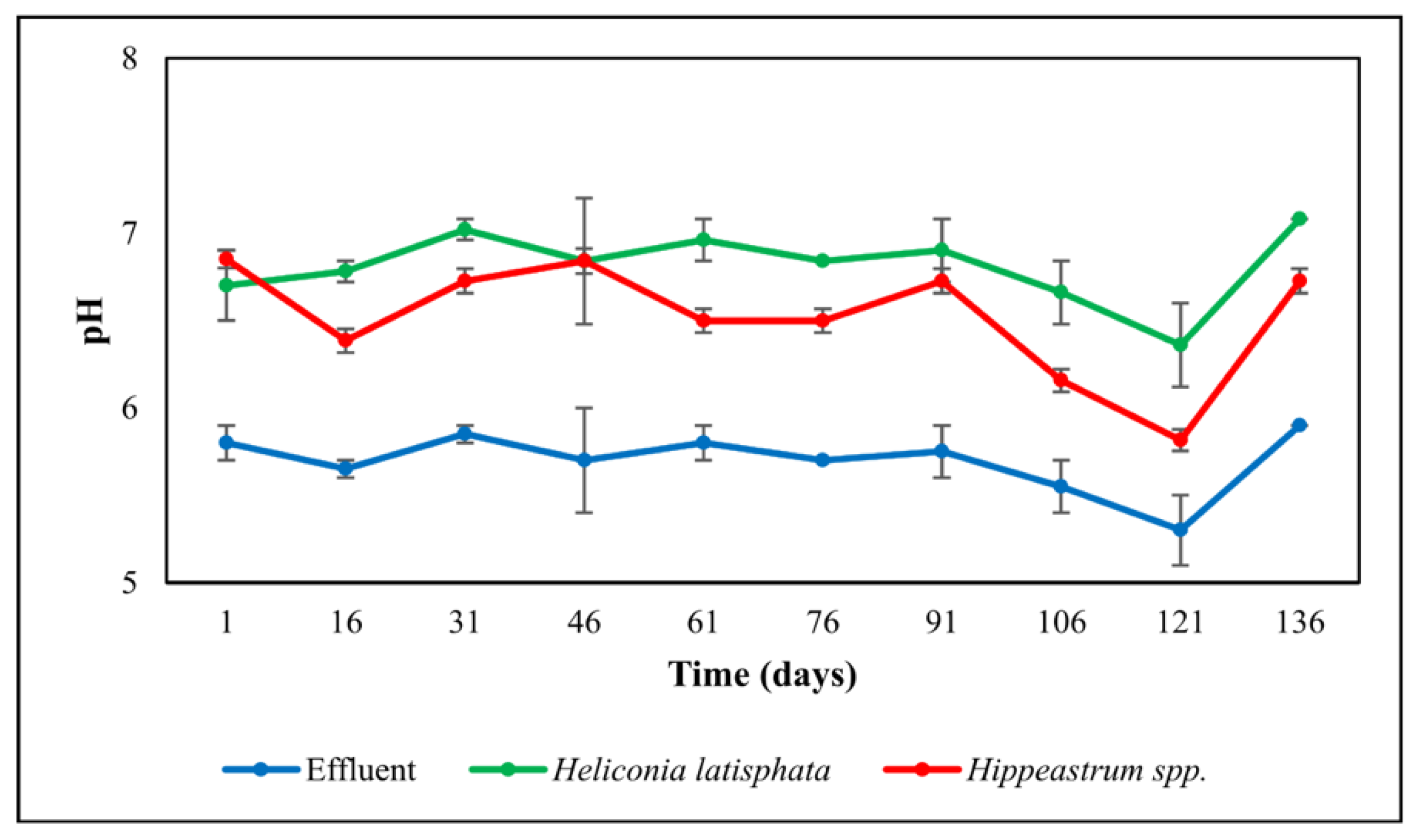
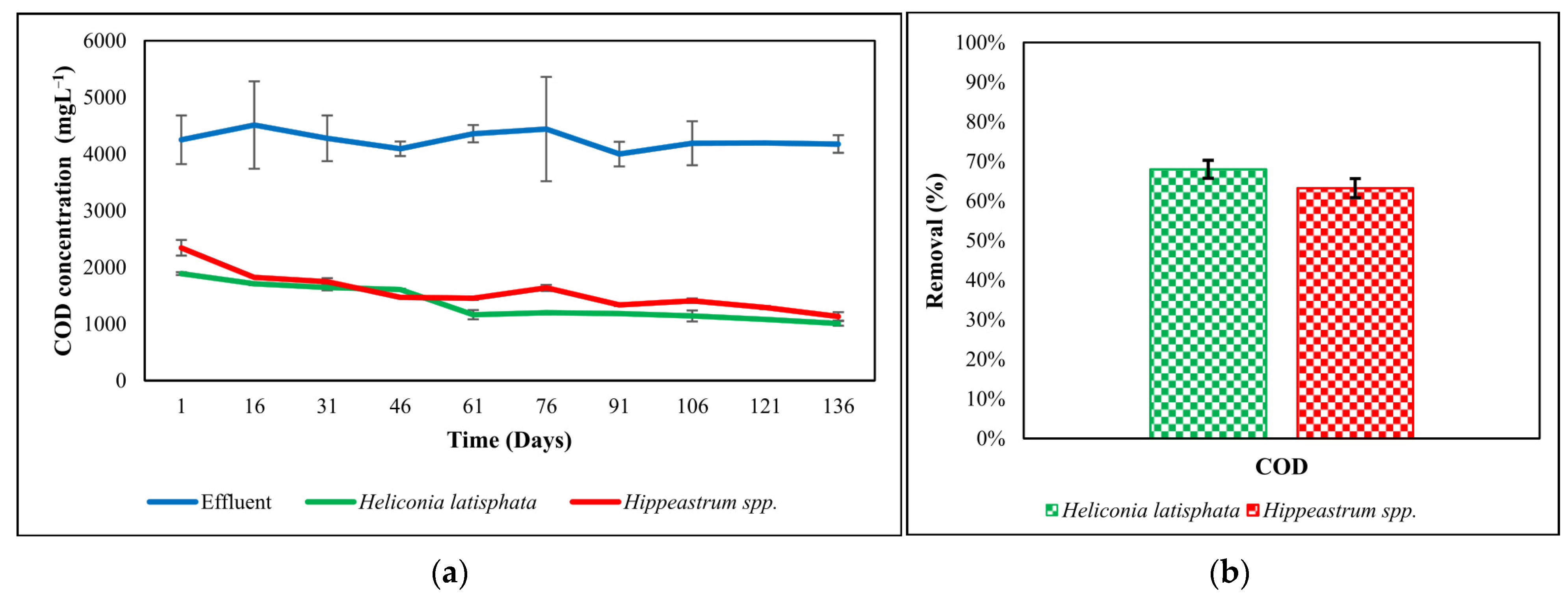

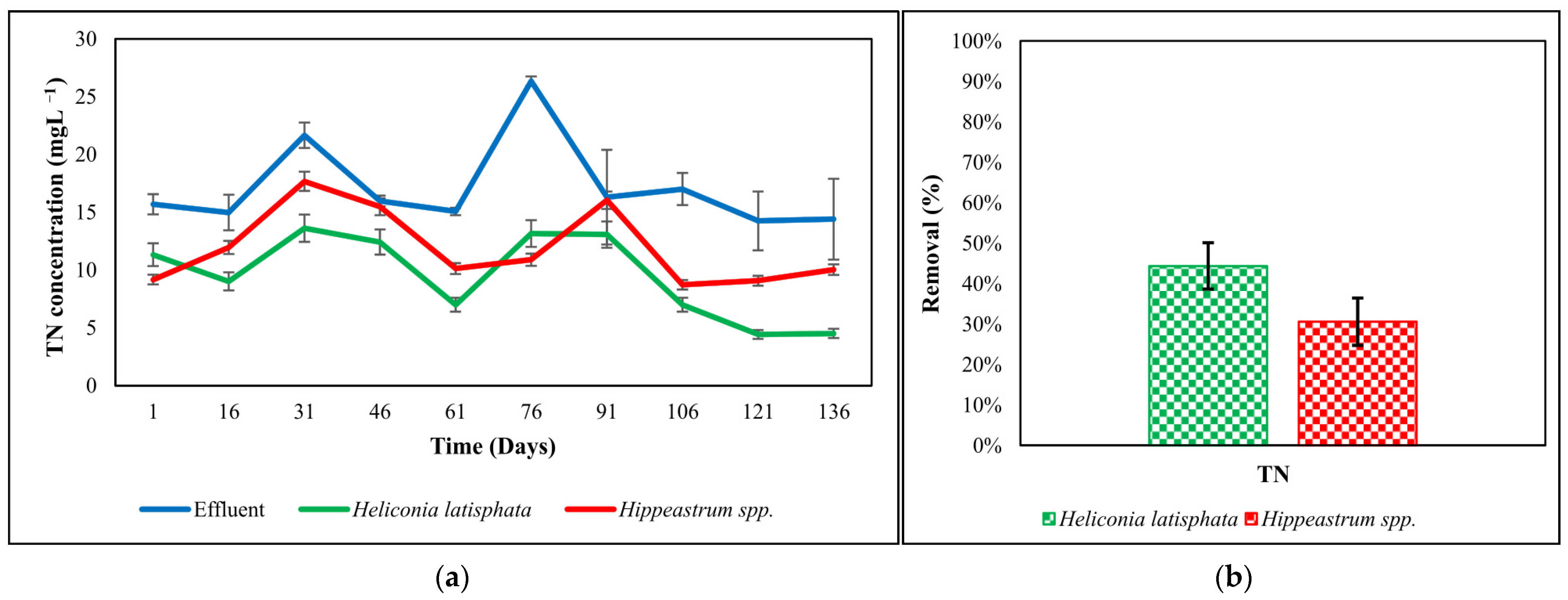


| Parameter | mg L−1 |
|---|---|
| COD | 14,310 ± 452 |
| TSS | 1700 ± 620 |
| TP | 67 ± 16 |
| TN | 713 ± 149 |
| Fats and Oils | 192 ± 61 |
| pH | 5.4 ± 1.2 |
| Parameter | mg L−1 |
|---|---|
| COD | 4248.4 ± 49.09 |
| TSS | 264.45 ± 11.26 |
| TP | 4.73 ± 0.35 |
| TN | 17.16 ± 1.22 |
| N-NH4 | 5.72 ± 0.19 |
| pH | 5.7 ± 0.05 |
| DO | 5.7 ± 0.17 |
| Parameter |  Hippeastrum striatum | 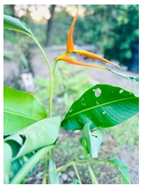 Heliconia latisphata | |
|---|---|---|---|
| Plant height | Initial | 15.8 ± 2.1 | 16.1 ± 2.5 |
| Final | 58.3 ± 6.2 | 74 ± 8.7 | |
| Number of shoots | Initial | 0 | 0 |
| Final | 0.6 ± 0.5 | 0.3 ± 0.5 | |
| Number of flowers | Initial | 0 ± 0 | 0 ± 0 |
| Final | 7 ± 1.4 | 3.3 ± 1.3 | |
| Number of leaves | Initial | 1.8 ± 0.5 | 1.9 ± 0.7 |
| Final | 6.1 ± 1.1 | 10.8 ± 2.7 | |
| Parameter | Before Treatment | After Treatment with: | Maximum Permissible Limits NOM-001-SEMARNAT-2021 | |
|---|---|---|---|---|
| Hippeastrum striatum | Heliconialastisphata | |||
| Temperature | 1 35 °C | 1 35 °C | 1 35 °C | 35 °C |
| pH | 2 5.7 | 1 6.5 | 1 6.8 | 6–9 |
| TSS | 2 264.45 mg L−1 | 2 134.92 | 2 114.62 | 60 mg L−1 |
| COD | 2 4248.4 mg L−1 | 2 1564.4 | 2 1361.9 | 210 mg L−1 |
| Total Nitrogen | 1 17.16 mg L−1 | 1 11.91 | 1 9.54 | 25 mg L−1 |
| Total Phosphorus | 1 4.73 mg L−1 | 1 3.05 | 1 2.51 | 15 mg L−1 |
| Substrate | Vegetation | Type of Cultivation | Type of WW | Type of CW | Removal | Site | Authors |
|---|---|---|---|---|---|---|---|
| Silica quartz river gravel | Giant reed (Arundo donax L.) and umbrella sedge (Cyperus alternifolius L.) | Monoculture | Dairy farm | Horizontal sub-surface flow constructed wetland | BOD 76%, COD 62%, TN 50.70% and microbiological parameters 80.00% | Sicily (Italy) | [14] |
| River gravel | Typha domingensis | Monoculture | Dairy factory | Horizontal subsurface flow constructed wetlands | STT 78.4%, BOD 57.9%, COD 68.7%, TN 25.7%, Nitrates 47.8% y TP 29.9% | Santa Fe, Argentina | [17] |
| Fine gravel | Typha latifolia | Monoculture | Industry cheese production | horizontal sub-surface flow constructed wetlands | TP: 73.2%, COD: 98%, N-N-NO4: 73.2%, TSS: 99.5% | North Italian Apennines | [60] |
| Light Expanded Clay Aggregate (LECA) | Typha domingensis and Phragmites australis | Monoculture and polyculture | Tertiary treatment in dairy Industry | Horizontal subsurface flow constructed wetlands | Ammonium 96%, Nitrite 96%, COD 75%, TSS 81.1% and TP 88.5% | Santiago del estero, Argentina | [61] |
| Stone, Gravel, Sand and Soil | Phragmites australis and Juncaeae spp. | Monoculture | Dairy Industry | Vertical flow constructed wetlands | COD 92.33%, TSS 86.04%, Turbidity low 246-74.7 NTU, PH low 7.83–6.86 | Iran | [62] |
| Sand with chalk, sand with iron and pea gravel | Napier Grass (Pennisetum Purpureum Schumach) | Monoculture | Dairy Farm | Vertical subsurface flow constructed wetlands | TN 60%, BOD71%, NH4 75%, COD 90% | Los Baños, Filipinas | [63] |
| Gravel and Sand | Canna indica | Monoculture | Dairy farm | Vertical flow constructed wetland | TSS 64.2–74.5%, NH4–N 29.6–56.5%, P 20.5–57.8%, y | Uttarakhand, India | [64] |
| Sand and gravel | Heliconia spp. and Eichornia crassipes | Monoculture | Ibuprofen and caffeine | vertical flow and free-floating | TN 99%, NH4+ 99%, emerging contaminants ibuprofen 97%, caffeine 89%, and COD 90% | Mato Grosso, Brasil | [65] |
| Sand and gravel | Scirpus grossus | Monoculture | Ibuprofen | vertical sub-surface flow constructed wetland | Ibuprofen 99.3%, COD 88.2%, NH4 99.1%, nitrate-nitrogen 72.9% and orthophosphate 83.2% | Bangi, Selangor, Malasia | [66] |
| Red volcanic gravel and RVG + polyethylene | Hippeastrum rutilum and Spathiphyllum wallisii | Monoculture and Polyculture | Fruit and Vegetable Waste | vertical subsurface flow and bioreactor | COD 90%, Tot-P 80%, TN 85% Polyculture COD, Tot-P, and TN > 90% | Orizaba, Mexico | [67] |
| River cobble and gravel | Cyperus papyrus and Heliconia spp. | Monoculture | Wastewater | Subsurface flow constructed wetlands | COD 66% and TSS 72% | Central Pacific Coast of Costa Rica | [68] |
| Red volcanic gravel | Heliconia latisphata and Hippeastrum striatum | Monoculture | Dairy Industry | HSSFW | OD 50%, STT 56.49 and 48.79%, COD 67.94 and 63.18%, TN 44.36 and 30.59%, N-NH4+ 51.8 and 50.80% TP 35 and 49% | Misantla, Veracruz | This research |
Disclaimer/Publisher’s Note: The statements, opinions and data contained in all publications are solely those of the individual author(s) and contributor(s) and not of MDPI and/or the editor(s). MDPI and/or the editor(s) disclaim responsibility for any injury to people or property resulting from any ideas, methods, instructions or products referred to in the content. |
© 2023 by the authors. Licensee MDPI, Basel, Switzerland. This article is an open access article distributed under the terms and conditions of the Creative Commons Attribution (CC BY) license (https://creativecommons.org/licenses/by/4.0/).
Share and Cite
Mateo-Díaz, N.F.; Sandoval Herazo, L.C.; Zurita, F.; Sandoval-Herazo, M.; Nani, G.; Fernández-Echeverría, E.; Fernández-Lambert, G.; Martínez-Reséndiz, G. Remediation of River Water Contaminated with Whey Using Horizontal Subsurface Flow Constructed Wetlands with Ornamental Plants in a Tropical Environment. Water 2023, 15, 3456. https://doi.org/10.3390/w15193456
Mateo-Díaz NF, Sandoval Herazo LC, Zurita F, Sandoval-Herazo M, Nani G, Fernández-Echeverría E, Fernández-Lambert G, Martínez-Reséndiz G. Remediation of River Water Contaminated with Whey Using Horizontal Subsurface Flow Constructed Wetlands with Ornamental Plants in a Tropical Environment. Water. 2023; 15(19):3456. https://doi.org/10.3390/w15193456
Chicago/Turabian StyleMateo-Díaz, Nicolás Francisco, Luis Carlos Sandoval Herazo, Florentina Zurita, Mayerlin Sandoval-Herazo, Graciela Nani, Eduardo Fernández-Echeverría, Gregorio Fernández-Lambert, and Georgina Martínez-Reséndiz. 2023. "Remediation of River Water Contaminated with Whey Using Horizontal Subsurface Flow Constructed Wetlands with Ornamental Plants in a Tropical Environment" Water 15, no. 19: 3456. https://doi.org/10.3390/w15193456








